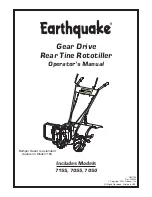
82
GB
will start and the tines will begin to rotate.
2.
Keep hold of the switch trigger (14) while releasing the safety lock button (1).
3.
To stop the appliance, release the switch trigger (14) and it automatically returns
to its start position.
Repeat this process several times so that you are sure that the machine
functions properly.
Before you perform any repair оr maintenance work оn the machine, ensure
that the cutting unit is not rotating and that the power supply is disconnected.
Always ensure that а safe distance (provided bу the long handles) is
maintained between the user and the housing.
The safety distance between housing and user given bу the handle must
always be observed. Ве especially careful when digging and changing direction
on slopes and inclines.
Maintain а solid footing and wear sturdy, non-slip footwear and long trousers.
Always dig along the incline (not up and down). For safety reasons, the Electric
Tiller may not bе used to dig up inclines whose gradient exceeds 15 degrees.
Use special caution when backing up and pulling the implement (tripping
hazard)!
Tips
⚫
Move the application to the work area prior to starting the motor.
⚫
Hold the application firmly while switching it on.
⚫
The tines will pull the tiller forward during operation. Press the handle to
lower the tines slowly.
⚫
By pulling the tiller back towards yourself, the tines will dig deeper and more
aggressively.
⚫
For breaking sod or deep tilling, allow the tines to pull the tiller forward to
the end of your arm’s reach, then firmly pull the tiller back towards you. By
repeatedly allowing the tiller to move forward and then pulling it back to you,
the tiller will be most effective.
⚫
If the tiller digs deep enough to stay in one spot, gently rock the tiller side to
side to start the tiller moving forward again.
⚫
For preparing a seed bed, we recommend using one of the tilling patterns
shown in Fig. 9.
Tilling Pattern A – Make two passes over area to be tilled, the second at a right
angle to the first.
Tilling Pattern B – Make two passes over area to be tilled, the second
overlapping the first.







































